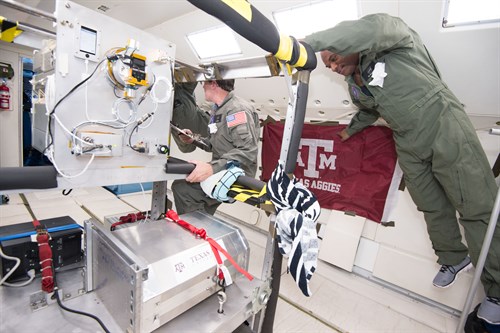
Dr. Cable Kurwitz and three Texas A&M Undergraduate Engineering students recently completed a successful flight test program aboard NASA’s reduced gravity aircraft of the Demonstration of a variable heat rejection (DoVR) system. The technology relies upon the exchange of liquid and a non-condensible gas between selected radiator coolant transport lines and a vortex phase separator. The reduced gravity aircraft flight provided by NASA’s Flight Opportunities Program allowed for demonstration of fluid handling in a near zero gravity environment and served as a precursor flight for the upcoming suborbital mission. Further news stories can be found here, here, here, and here.
Phase Separator in Operation
The vortex separator developed at Texas A&M and licensed to Advanced Cooling Technologies is a passive device with no moving parts that relies on the momentum of the incoming fluid to produce a rotational flow within the device. The flow field produces a radial acceleration that drives the separation process which can acheive high throughput compared to capillary devices. Videos of the device operating under Earth-g and during NASA reduced gravity aircraft testing show how the acceleration field can be designed to operate against gravity or to minimize the pumping power under zero gravity conditions. Another design feature is that the liquid inventory can change by controlling the gas volume within the separator which allows the device to both separate and serve as an accumulator. This feature makes the separator ideal for the DoVR radiator system since liquid and gas must be exchanged between the separator and selected radiator segments.


